Oufu Optical Fiber Cable Co.,Ltd
Address: Shenyang, Liaoning, China
Contact person: Manager Zhang
Phone: 400-964-1314
Mobile phone: +86 13904053308
【whatsapp && wechat】
2024-04-19 2462
Fiber Optic Connectors: Standard Specifications and Materials
Fiber optic connectors come in a variety of standard specifications and materials, each tailored to meet specific application requirements. Here is a closer look at some common types and their relevant characteristics

In terms of specifications:
Outer Diameter: Most fiber optic connectors have an outer diameter of 2.5mm, which is a common standard size.
Operating Wavelength: Fiber optic connectors typically support multiple operating wavelengths such as 850nm, 1300nm, 1310nm, and 1550nm, allowing them to be used in various fiber optic communication systems.
Insertion Loss: Insertion loss is a crucial parameter that measures the attenuation of light signals passing through the connector. Quality fiber optic connectors typically have an insertion loss of less than 0.5dB.
Mating Cycles: Mating cycles refer to the number of times a connector can be inserted and removed under normal operating conditions. Fiber optic connectors typically have a mating life of over 1000 cycles, ensuring stability and reliability.
In terms of materials:www.adsscable.cn
Ceramic: Ceramic is commonly used in fiber optic connectors, especially for the end faces and sleeves. Its excellent wear resistance and stability ensure efficient transmission of light signals through the connector.www.adsscable.cn
Plastics: Plastics are mainly used for the connector's housing and protective sleeves. Common plastic materials include PVC and nylon. Plastics are cost-effective and suitable for indoor applications.
Metals: Metals are often utilized for the connector's housing and clamping mechanisms. Common metallic materials include stainless steel, copper, and aluminum. Metals provide excellent mechanical properties and stability, ensuring the connector's durability and robustness.
It's worth noting that specific specifications and materials may vary depending on different manufacturers, application scenarios, and customer requirements. When selecting fiber optic connectors, it is recommended to evaluate and choose based on the actual application needs and performance requirements.
www.adsscable.cn
This brief overview provides a glimpse into the diverse world of fiber optic connectors and their various specifications and materials. Understanding these aspects is crucial for selecting the right connector for a given application, ensuring optimal performance and reliability in fiber optic communication systems.